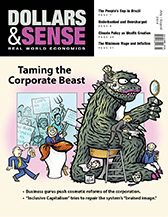40th Anniversary Excerpt
“Free Trade” and Jobs
This article is from Dollars & Sense: Real World Economics, available at http://www.dollarsandsense.org

This article is from the July/August 2014 issue.
Subscribe Now
at a 30% discount.
It’s easy to forget, decades into the era of neoliberal economic policies and “free trade” agreements, that these policies are of recent vintage. In the late 1990s and early 2000s, the restructuring of the world capitalist economy along “free market” lines was being hotly contested. Massive protests met virtually every World Trade Organization (WTO), International Monetary Fund (IMF), or World Bank meeting. Every new proposed “free trade” agreement—really mainly agreements to strip away restrictions on the international movement of capital—spurred new controversy. Some, like the North American Free Trade Agreement (NAFTA) went through. Others, like the Free Trade Area of the Americas (FTAA), were beaten back.
In this selection from 2003, economist Ellen Frank looked back at nine years of NAFTA’s effects on labor in both the United States and Mexico. As she pointed out, globalization dominated by capital, of which NAFTA is a part, “weakens unions, strengthens multinationals, and increases competition and insecurity all around.” That, of course, was the whole point. Today, as we’re facing new waves of the same tide—like the Trans-Pacific Partnership (TPP)—we should remember that many people once believed that the answer to corporate globalization was not a retreat behind national borders, but a new kind of “globalization from below.” For now, the high and mighty have mostly won, and we have mostly lost. But history’s not done yet. —Eds.
S ince the North American Free Trade Agreement (NAFTA) between the United States, Mexico, and Canada went into effect, trade within North America has increased dramatically. Exports from the United States to Mexico have risen 150% and exports to Canada are up 66%. This much is beyond dispute.
NAFTA’s effects on employment, on the other hand, are hotly debated. Clinton administration officials estimated in the late 1990s that expanded trade in North America had created over 300,000 new U.S. jobs. Economic Policy Institute (EPI) economists Robert Scott and Jesse Rothstein contend, however, that such claims amount to “trying to balance a checkbook by counting the deposits and not the withdrawals.”
This is because NAFTA and other trade agreements have also increased U.S. imports from Canada and Mexico—and by quite a lot more than exports. Since 1993, America’s trade deficit with its North American trading partners (exports minus imports) has ballooned from $16 billion to $82 billion annually. As Scott points out, “increases in U.S. exports create jobs in this country, but increases in imports destroy jobs because the imports displace goods that otherwise would have been made in the U.S. by domestic workers.”
Employment in virtually all U.S. manufacturing industries has declined since NAFTA went into effect. Counting jobs that actually left the United States plus those that would have been created if not for rising imports, EPI estimates that NAFTA caused a net loss of 440,000 U.S. jobs. In fact, during the 1990s, the overall U.S. trade deficit quadrupled, resulting in a net loss of three million jobs, according to EPI president Jeff Faux.
Of course, in a large and complex economy, trade is only one of many factors that affect job creation, and its influence is difficult to isolate. As trade expanded during the 1990s, for example, the United States also experienced an investment boom that created jobs faster than rising imports destroyed them; overall, the number of jobs in the United States has risen by 28 million since 1994.
Any free-trade booster worth her lobbying fees would argue that the boom itself resulted from liberalized trade. Lower trade and investment barriers, the story goes, unleash entrepreneurial talents, spurring innovation and productivity gains. Old jobs lost are offset by new jobs gained, and falling wages by cheaper prices on imported goods. Moreover, free- traders contend, any reckoning of NAFTA’s impact should tote up new jobs and factories in Mexico against shuttered plants in the United States.
So what about NAFTA’s effect on Mexico? Analysts Timothy Wise and Kevin Gallagher conclude that NAFTA has given Mexico “trade without development.” Since NAFTA weakened barriers to U.S. investment in Mexico, foreign investment into the country tripled and exports grew rapidly. But the development promised by free-trade advocates never materialized.
The result is one thing that almost everybody who studies trade now agrees upon. Whatever else they have wrought, globalized trade and production coincide with greater inequality both within and between countries. The reasons for this are complex—globalization weakens unions, strengthens multinationals, and increases competition and insecurity all around— but the data are clear. Markets do not distribute wealth equitably.
Did you find this article useful? Please consider supporting our work by donating or subscribing.
